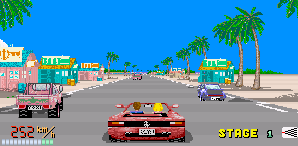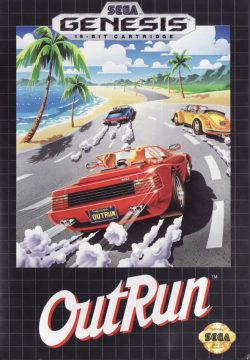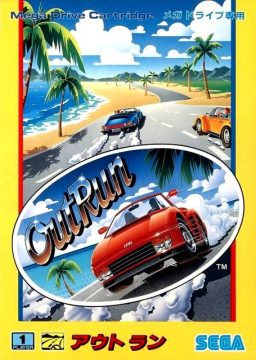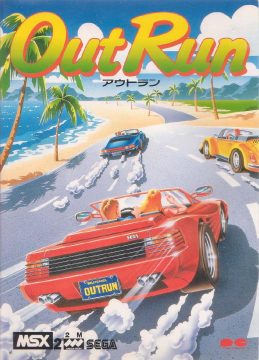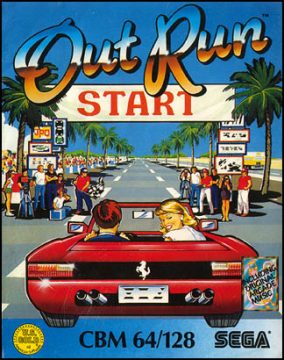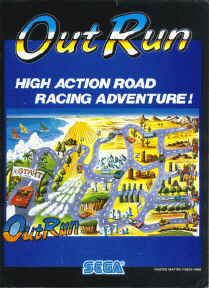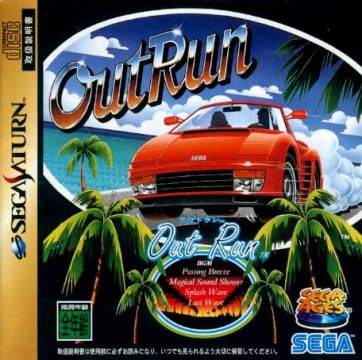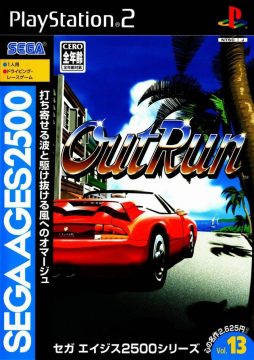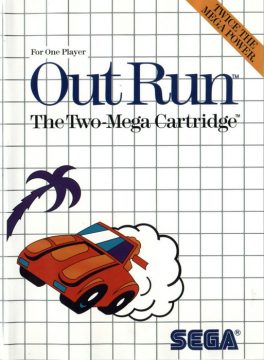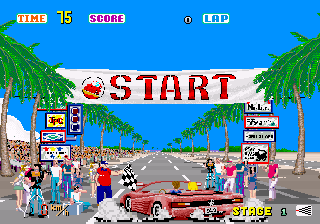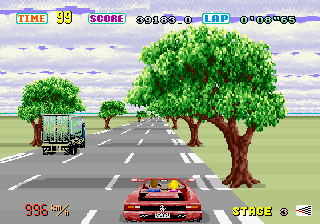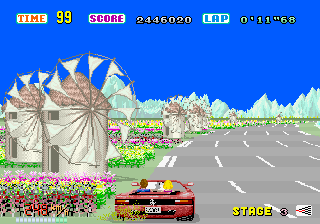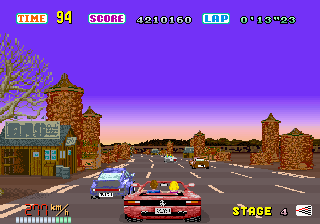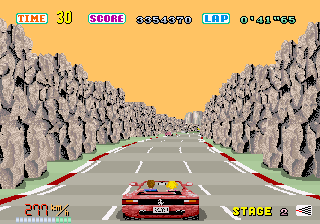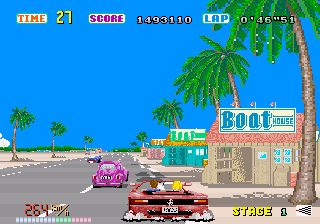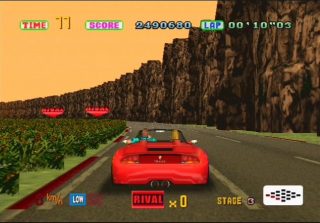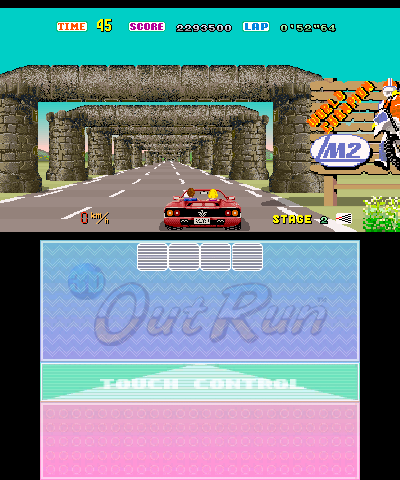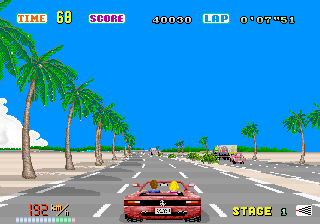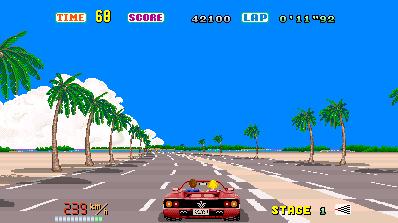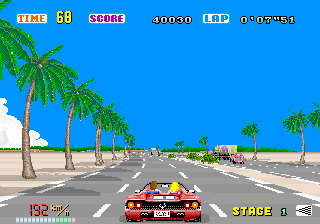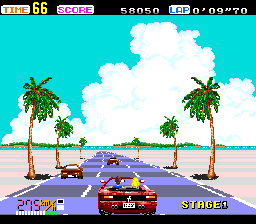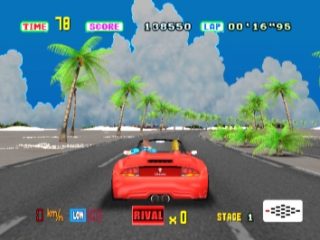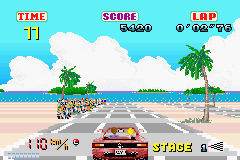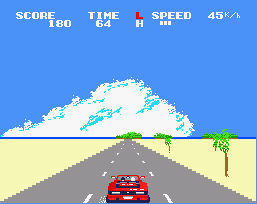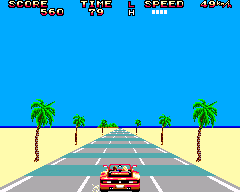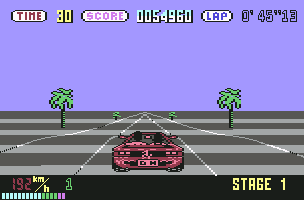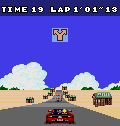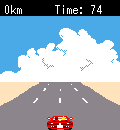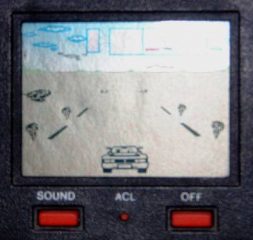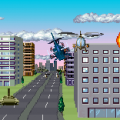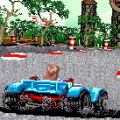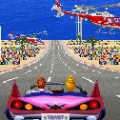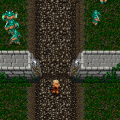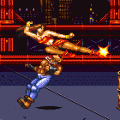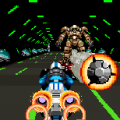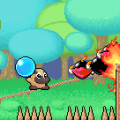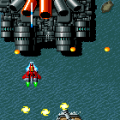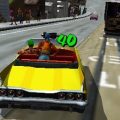OutRun is known as one of the finest arcade racing games ever made. Created by Yu Suzuki and Sega-AM2, it utilizes the “super scaler“ technology seen in Hang-On, After Burner and Space Harrier. It runs on a board built specifically for the game called the Sega OutRun Hardware, which is based on the System 16 board. The blazing fast scaling of the sprites and slick 3D motion of the road created an experience far smoother than most other arcade titles around at the time.
According to Yu Suzuki, OutRun was inspired by the 1981 movie The Cannonball Run, which featured a huge race across Europe in a variety of fancy cars. In transferring that concept into a game, Suzuki put you in the seat of an expensive sports car, which looks suspiciously like a Ferrari Testarossa, as you speed through a variety of exotic locations. The race begins on the beach, but spreads to deserts, canyons, forests and a diverse selection of other scenic routes.
The game itself is uncomplicated – there are no laps around circuits, no sponsors, no pit stops, no ramming, and no high speed chases. Just weaving through turns, dodging cars, and shifting gears when appropriate. If you run off the road and hit an obstacle you may flip over, but within a few seconds you’re back on the road completely unharmed. The whole experience has a very laid back feeling; just cruising along, sunglasses on and hot blonde girlfriend by your side, relaxing, and looking forward to whatever new sights the next stage will bring.
At the end of each stage the road forks in two directions, each leading to a different area. A single game from start to finish only comprises five stages, but with all of the branching paths, there are a total of 15 unique tracks. Each course also has their own unique ending, some of which are quite silly. The map, laid out like a sideways pyramid, is displayed at the end of the game and charts your progress. There are minor differences between the circuit layouts of the “Overseas“ and “Japanese“ versions.
The graphics have that fresh, clean and bright AM2 style, and the music tracks, supplied by Hiroshi Kawaguchi, are classics. There are three different in-game songs (“Magical Sound Shower“, “Splash Wave“ and “Passing Breeze“), selected via a radio at the start of the game, and each has a catchy Latin/Caribbean influenced melody. Each song also lasts approximately the duration of the entire game, about six minutes or so. Even the game over / high score theme, entitled “Last Wave“, relaxes you while you stare at the sunset and listen to the sound of waves breaking.
OutRun hit the arcades in 1986 in four different cabinets: two upright ones, a standard sit-down one, and a deluxe sit-down cabinet, the latter being equipped with hydraulics that move the seat to the sides when you turn. These cabinets are also equipped with force feedback motors which shake the steering wheel as you turn or crash.
Since none of the 8- or 16-bit systems were as powerful as the arcade hardware, everything had to be scaled back. Some of the computer ports shipped with a soundtrack tape as a bonus.
The Master System is of reasonable quality given the technical constraints. The scrolling is relatively good for an 8-bit system and the music sounds decent. Many of the roadside details are missing, though, along with the horizon backgrounds.
Despite running on nearly identical hardware, the Game Gear version, ported by SIMS, is completely different from the Master System release. The sprites are smaller (and uglier) to compensate for the smaller screen, but some of the missing details have returned, like the backgrounds on the horizon and various other sprites. However, the roads feel cramped, and it’s more difficult. There’s also a versus mode where you can race against a CPU opponent or link up to another player with a Game Gear and copy of the game.
The Genesis version was ported by Hertz. While not powerful enough to handle scaling, but it definitely looks nicer than any previous version. It also has an exclusive fourth selectable song called “Step on Beat“. There’s an extra ending screen, as well as cameos from the After Burner and Galaxy Force ships, if you manage to meet certain conditions. The PC Engine version was only released in Japan, and was ported by NEC Avenue. It’s not as nice looking as the Genesis version, but it plays just fine.
US Gold published the ports for various home computers, and most were programmed by Probe Software. The Atari ST and Amiga ports are essentially identical, though the Amiga has the edge on music. The graphics are more colorful than the 8-bit ports, but they still look fairly bad, and the framerate is not very good.
The Commodore 64 version, ported by Amazing Products, is a decent conversion, though the roads are the same color as the rest of the ground. It can’t handle the forked paths either, so instead you pick from one of five courses before you begin the game. The music is decent, but “Passing Breeze“ is missing. The IBM PC version was ported by Unlimited Software, and while it’s stuck with 16 color EGA graphics and PC speaker sound, it plays well.
The Amstrad version is terrible. Like the Commodore 64 version, the road is the same color as the rest of the ground, but it’s so incredibly slow that it’s a wonder anyone allowed it to be published. The ZX Spectrum version is only slightly better, in that the speed is slightly faster, though not by much. The MSX version is practically identical to the Spectrum port. An MSX2 version, released in Japan and ported by Pony Canyon, is roughly on par with the SMS version.
The first arcade perfect port arrived in 1996 on the Saturn as part of the Sega Ages collection (which was compiled with two other games and published by Working Designs in North America and Sega in Europe). Ported by Rutubo Games, it includes a hidden option to make the game run at 60 FPS (the arcade original only ran at 30 FPS). The Japanese version also has newly arranged tracks, but these were excised from the overseas releases.
OutRun also appeared on the Dreamcast, compiled in the Yu Suzuki Game Works Vol. 1 disc, as well as appearing as playable minigames in both Shenmue titles. It runs at a higher resolution than the arcade game, so there is slightly more detail in the sprites, though it’s hard to tell. The music also sounds a little different. Perhaps there were also legal concerns at one point, because the car has been redrawn to look less like a Testarossa. It is also missing the niceties of the Saturn version. A straight emulation of the arcade game is available in the Xbox version of OutRun 2.
OutRun is also included in the Sega Arcade Gallery for the GBA, developed by Bits Studios. While most games on this compilation suffer from shoddy programming, OutRun turned out pretty well, with 60 FPS speed like the Saturn version, though the roadside objects are missing some details.
Sega also released the game as part of their 3D Ages collection as part of the Sega Ages 2500 budget line, redoing the entire game in 3D. While the gameplay feels faithful, the car is too large, and positioned too far up on the screen, making it difficult to see into the distance. The graphics are ugly, with grainy textures and interlacing artifacts, though at least it runs at 60 FPS.
There’s a new “Arrange Mode“ which is almost a brand new game, adding in a whole bunch of new courses that take advantage of the shift to true 3D. Whereas the levels in the original OutRun were mostly flat with some hills and curves, this mode adds more mountainous terrain. The circuit layout is completely different, and there are now rival cars to beat. There are also more brand new remixes of the songs. This version made it to America and Europe on the Sega Classics Collection for the PS2.
Also of note is Cannonball, a homebrew engine that uses the original arcade ROMs and adds several enhancements, including 60 FPS speed, widescreen view, bug fixes, time trial modes, and support for homemade tracks from a program called LayOut.
3D OutRun for the 3DS includes widescreen view and 60 FPS, as well as several color variations and unlockable mods to tweak your car’s handling, acceleration, and top speed. There are also two catchy new songs that fit in perfectly: “Camino a Mi Amor” and “Cruising Line”. Unfortunately, like the DC release, the car sprite is changed due to licensing issues.
